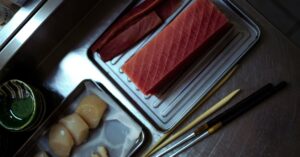Do you ever wonder if Japanese people really use chopsticks for sushi? As someone who loves exploring new cuisines, I used to wonder the same thing.
After visiting Japan and dining at sushi restaurants in Tokyo, I learned firsthand that yes, chopsticks are an essential part of the sushi eating experience. Sushi is a delicate food meant to be eaten with care, and chopsticks allow Japanese diners to handle each piece properly.
The thin, tapered chopsticks called “hashi” in Japanese can maneuver sushi pieces of all shapes and sizes. Made of wood, bamboo, or plastic, they are decorated with beautiful designs in various colors. Measuring about 9 inches long, these chopsticks gracefully pick up sushi to deliver optimal taste and texture. Beyond sushi, chopsticks are used for most dishes in Japan. They are an important part of Japanese culture and cuisine.
So next time you enjoy sushi, don’t be afraid to use chopsticks to fully immerse yourself in the Japanese dining tradition. There is an elegant art to sushi eating with chopsticks that I can’t wait to share more about later in this article!
Why Chopsticks are Ideal for Sushi
Chopsticks, called “hashi” in Japanese, have some advantages over forks and fingers when eating sushi:
- Pick up pieces cleanly – The thin, tapered ends can grab sushi without smashing or dropping it. Forks often pierce and damage sushi pieces.
- Manipulate small items – Chopsticks can pick up even the smallest morsels of food, like individual grains of rice.
- Eat sushi mannerly – Using chopsticks displays polite table manners in Japan.
- Enjoy subtle flavors – Chopsticks don’t alter flavors like metal forks can. The wood, bamboo or plastic builds don’t impart any taste.
- Prevent contamination – With minimal contact between hands and food, chopsticks promote hygienic eating.
The Origins and Design of Japanese Chopsticks
Chopsticks likely originated in China over 3000 years ago before spreading across East Asia. In Japan, they evolved with a unique aesthetic:
- Length – Japanese chopsticks are longer at about 9 inches to reach dishes placed farther away.
- Tapered tip – The ends taper gracefully to a point to pick up small bites.
- Decorative – Intricate patterns and colors embellish the sticks. Designs may contain flowers, animals, or wood grain.
- Material – Chopsticks are carved from natural materials like wood, bamboo, and plastic. Higher quality wood comes from the lacquer tree.
Beyond form, Japanese etiquette governs how chopsticks are used, from initially picking them up to resting them when done. Proper technique demonstrates respect.
How to Eat Sushi Like a Pro with Chopsticks
Eating sushi with chopsticks takes some practice. Here are helpful techniques to look like a pro:
- Grip – Hold one stick between your thumb and middle finger. The other should rest between your index and middle fingers. Move the top stick with your index finger to “pinch” food.
- Support the sushi – Use your free hand to hold dishes steady as you grab pieces. Don’t wave sticks around trying to chase food.
- Choose wisely – Pick up sushi toppings-side up to avoid dropping fillings. For rolls, lift from the side or top to avoid splitting the rice.
- Small bites – Take modest bites of sushi instead of cramming large pieces in your mouth. This shows manners and allows you to savor flavors.
- Soy sauce – Lightly dip just a corner of sushi in soy sauce so as not to overpower the taste. Never soak or submerge sushi in soy.
- Move forward – When eating sushi courses, start with lighter items and move to heavier, bolder morsels.
With some practice, using chopsticks for sushi becomes second nature. As an essential tool for Japanese cuisine, chopsticks are part of what makes the sushi experience special.
Frequently Asked Questions About Chopsticks and Sushi
If you’re new to using chopsticks for sushi, you likely have some questions. Here are answers to common FAQs:
Are chopsticks required for eating sushi in Japan?
Chopsticks are the customary utensil, but not absolutely required. Many sushi restaurants offer forks for those unaccustomed to chopsticks. Handrolls and nigiri can also be eaten with fingers.
What if I can’t use chopsticks well?
It’s fine to ask for a fork at restaurants if you struggle with chopsticks. Learning takes practice. You can also request chopstick assistance – many places offer clip-on grabber picks.
Should chopsticks touch soy sauce?
No, you should dip just the sushi into soy sauce – never submerge the chopstick tips. This prevents spreading germs should you re-use the chopsticks for more food.
Are disposable chopsticks acceptable?
Yes, disposable wood or plastic chopsticks are common at sushi restaurants. They are seen as hygienic since you don’t reuse them.
How do I know which chopstick to use first?
In Japan, it’s proper to use the left chopstick first when picking up pieces. But as a beginner, just focus on holding the sticks correctly without worrying about order.
Time To Try Chopsticks with Sushi!
I hope this gives you insight into why chopsticks are integral for sushi in Japan. Next time you visit a sushi restaurant, don’t be afraid to request a pair of hashis to practice your technique. The elegance and etiquette of using chopsticks is part of the fun of sushi. With a bit of effort, you’ll be maneuvering sushi like a pro Japanese diner in no time. Now grab those sticks and get to savory sushi eating!
Let me know if you would like me to modify or expand upon this blog post draft. I aimed to provide comprehensive information on chopsticks and sushi in an engaging, conversational tone for foodie readers. Please provide any feedback so I can refine the content to best meet your needs.





